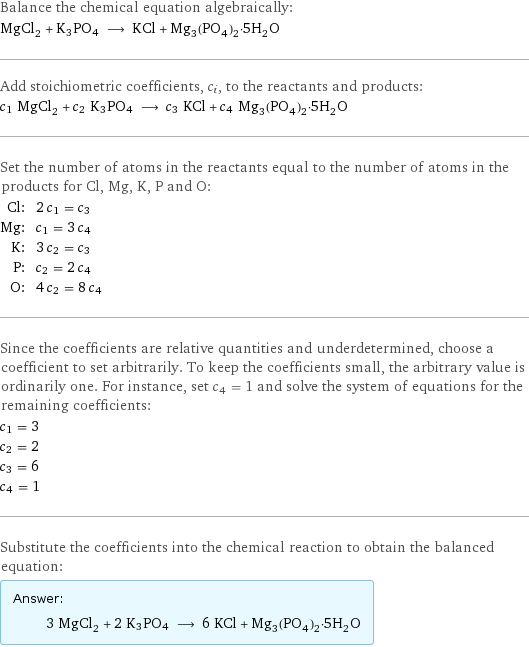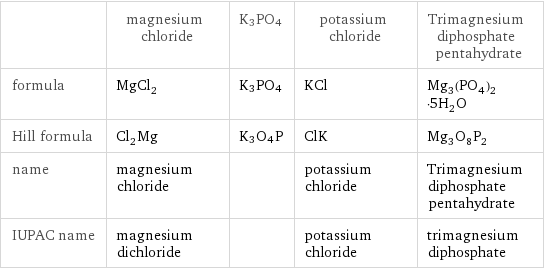Input interpretation

MgCl_2 magnesium chloride + K3PO4 ⟶ KCl potassium chloride + Mg_3(PO_4)_2·5H_2O Trimagnesium diphosphate pentahydrate
Balanced equation

Balance the chemical equation algebraically: MgCl_2 + K3PO4 ⟶ KCl + Mg_3(PO_4)_2·5H_2O Add stoichiometric coefficients, c_i, to the reactants and products: c_1 MgCl_2 + c_2 K3PO4 ⟶ c_3 KCl + c_4 Mg_3(PO_4)_2·5H_2O Set the number of atoms in the reactants equal to the number of atoms in the products for Cl, Mg, K, P and O: Cl: | 2 c_1 = c_3 Mg: | c_1 = 3 c_4 K: | 3 c_2 = c_3 P: | c_2 = 2 c_4 O: | 4 c_2 = 8 c_4 Since the coefficients are relative quantities and underdetermined, choose a coefficient to set arbitrarily. To keep the coefficients small, the arbitrary value is ordinarily one. For instance, set c_4 = 1 and solve the system of equations for the remaining coefficients: c_1 = 3 c_2 = 2 c_3 = 6 c_4 = 1 Substitute the coefficients into the chemical reaction to obtain the balanced equation: Answer: | | 3 MgCl_2 + 2 K3PO4 ⟶ 6 KCl + Mg_3(PO_4)_2·5H_2O
Structures

+ K3PO4 ⟶ +
Names

magnesium chloride + K3PO4 ⟶ potassium chloride + Trimagnesium diphosphate pentahydrate
Equilibrium constant
![Construct the equilibrium constant, K, expression for: MgCl_2 + K3PO4 ⟶ KCl + Mg_3(PO_4)_2·5H_2O Plan: • Balance the chemical equation. • Determine the stoichiometric numbers. • Assemble the activity expression for each chemical species. • Use the activity expressions to build the equilibrium constant expression. Write the balanced chemical equation: 3 MgCl_2 + 2 K3PO4 ⟶ 6 KCl + Mg_3(PO_4)_2·5H_2O Assign stoichiometric numbers, ν_i, using the stoichiometric coefficients, c_i, from the balanced chemical equation in the following manner: ν_i = -c_i for reactants and ν_i = c_i for products: chemical species | c_i | ν_i MgCl_2 | 3 | -3 K3PO4 | 2 | -2 KCl | 6 | 6 Mg_3(PO_4)_2·5H_2O | 1 | 1 Assemble the activity expressions accounting for the state of matter and ν_i: chemical species | c_i | ν_i | activity expression MgCl_2 | 3 | -3 | ([MgCl2])^(-3) K3PO4 | 2 | -2 | ([K3PO4])^(-2) KCl | 6 | 6 | ([KCl])^6 Mg_3(PO_4)_2·5H_2O | 1 | 1 | [Mg3(PO4)2·5H2O] The equilibrium constant symbol in the concentration basis is: K_c Mulitply the activity expressions to arrive at the K_c expression: Answer: | | K_c = ([MgCl2])^(-3) ([K3PO4])^(-2) ([KCl])^6 [Mg3(PO4)2·5H2O] = (([KCl])^6 [Mg3(PO4)2·5H2O])/(([MgCl2])^3 ([K3PO4])^2)](../image_source/c10b8c0684675c29a6091bda2a8d3f60.png)
Construct the equilibrium constant, K, expression for: MgCl_2 + K3PO4 ⟶ KCl + Mg_3(PO_4)_2·5H_2O Plan: • Balance the chemical equation. • Determine the stoichiometric numbers. • Assemble the activity expression for each chemical species. • Use the activity expressions to build the equilibrium constant expression. Write the balanced chemical equation: 3 MgCl_2 + 2 K3PO4 ⟶ 6 KCl + Mg_3(PO_4)_2·5H_2O Assign stoichiometric numbers, ν_i, using the stoichiometric coefficients, c_i, from the balanced chemical equation in the following manner: ν_i = -c_i for reactants and ν_i = c_i for products: chemical species | c_i | ν_i MgCl_2 | 3 | -3 K3PO4 | 2 | -2 KCl | 6 | 6 Mg_3(PO_4)_2·5H_2O | 1 | 1 Assemble the activity expressions accounting for the state of matter and ν_i: chemical species | c_i | ν_i | activity expression MgCl_2 | 3 | -3 | ([MgCl2])^(-3) K3PO4 | 2 | -2 | ([K3PO4])^(-2) KCl | 6 | 6 | ([KCl])^6 Mg_3(PO_4)_2·5H_2O | 1 | 1 | [Mg3(PO4)2·5H2O] The equilibrium constant symbol in the concentration basis is: K_c Mulitply the activity expressions to arrive at the K_c expression: Answer: | | K_c = ([MgCl2])^(-3) ([K3PO4])^(-2) ([KCl])^6 [Mg3(PO4)2·5H2O] = (([KCl])^6 [Mg3(PO4)2·5H2O])/(([MgCl2])^3 ([K3PO4])^2)
Rate of reaction
![Construct the rate of reaction expression for: MgCl_2 + K3PO4 ⟶ KCl + Mg_3(PO_4)_2·5H_2O Plan: • Balance the chemical equation. • Determine the stoichiometric numbers. • Assemble the rate term for each chemical species. • Write the rate of reaction expression. Write the balanced chemical equation: 3 MgCl_2 + 2 K3PO4 ⟶ 6 KCl + Mg_3(PO_4)_2·5H_2O Assign stoichiometric numbers, ν_i, using the stoichiometric coefficients, c_i, from the balanced chemical equation in the following manner: ν_i = -c_i for reactants and ν_i = c_i for products: chemical species | c_i | ν_i MgCl_2 | 3 | -3 K3PO4 | 2 | -2 KCl | 6 | 6 Mg_3(PO_4)_2·5H_2O | 1 | 1 The rate term for each chemical species, B_i, is 1/ν_i(Δ[B_i])/(Δt) where [B_i] is the amount concentration and t is time: chemical species | c_i | ν_i | rate term MgCl_2 | 3 | -3 | -1/3 (Δ[MgCl2])/(Δt) K3PO4 | 2 | -2 | -1/2 (Δ[K3PO4])/(Δt) KCl | 6 | 6 | 1/6 (Δ[KCl])/(Δt) Mg_3(PO_4)_2·5H_2O | 1 | 1 | (Δ[Mg3(PO4)2·5H2O])/(Δt) (for infinitesimal rate of change, replace Δ with d) Set the rate terms equal to each other to arrive at the rate expression: Answer: | | rate = -1/3 (Δ[MgCl2])/(Δt) = -1/2 (Δ[K3PO4])/(Δt) = 1/6 (Δ[KCl])/(Δt) = (Δ[Mg3(PO4)2·5H2O])/(Δt) (assuming constant volume and no accumulation of intermediates or side products)](../image_source/6ac9317a883a31fce14ac427b8d8d480.png)
Construct the rate of reaction expression for: MgCl_2 + K3PO4 ⟶ KCl + Mg_3(PO_4)_2·5H_2O Plan: • Balance the chemical equation. • Determine the stoichiometric numbers. • Assemble the rate term for each chemical species. • Write the rate of reaction expression. Write the balanced chemical equation: 3 MgCl_2 + 2 K3PO4 ⟶ 6 KCl + Mg_3(PO_4)_2·5H_2O Assign stoichiometric numbers, ν_i, using the stoichiometric coefficients, c_i, from the balanced chemical equation in the following manner: ν_i = -c_i for reactants and ν_i = c_i for products: chemical species | c_i | ν_i MgCl_2 | 3 | -3 K3PO4 | 2 | -2 KCl | 6 | 6 Mg_3(PO_4)_2·5H_2O | 1 | 1 The rate term for each chemical species, B_i, is 1/ν_i(Δ[B_i])/(Δt) where [B_i] is the amount concentration and t is time: chemical species | c_i | ν_i | rate term MgCl_2 | 3 | -3 | -1/3 (Δ[MgCl2])/(Δt) K3PO4 | 2 | -2 | -1/2 (Δ[K3PO4])/(Δt) KCl | 6 | 6 | 1/6 (Δ[KCl])/(Δt) Mg_3(PO_4)_2·5H_2O | 1 | 1 | (Δ[Mg3(PO4)2·5H2O])/(Δt) (for infinitesimal rate of change, replace Δ with d) Set the rate terms equal to each other to arrive at the rate expression: Answer: | | rate = -1/3 (Δ[MgCl2])/(Δt) = -1/2 (Δ[K3PO4])/(Δt) = 1/6 (Δ[KCl])/(Δt) = (Δ[Mg3(PO4)2·5H2O])/(Δt) (assuming constant volume and no accumulation of intermediates or side products)
Chemical names and formulas

| magnesium chloride | K3PO4 | potassium chloride | Trimagnesium diphosphate pentahydrate formula | MgCl_2 | K3PO4 | KCl | Mg_3(PO_4)_2·5H_2O Hill formula | Cl_2Mg | K3O4P | ClK | Mg_3O_8P_2 name | magnesium chloride | | potassium chloride | Trimagnesium diphosphate pentahydrate IUPAC name | magnesium dichloride | | potassium chloride | trimagnesium diphosphate
Substance properties

| magnesium chloride | K3PO4 | potassium chloride | Trimagnesium diphosphate pentahydrate molar mass | 95.2 g/mol | 212.26 g/mol | 74.55 g/mol | 262.85 g/mol phase | solid (at STP) | | solid (at STP) | solid (at STP) melting point | 714 °C | | 770 °C | 1357 °C boiling point | | | 1420 °C | density | 2.32 g/cm^3 | | 1.98 g/cm^3 | solubility in water | soluble | | soluble | insoluble odor | | | odorless |
Units
